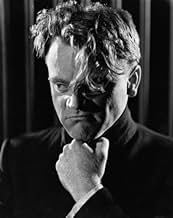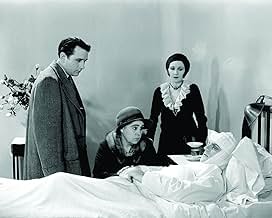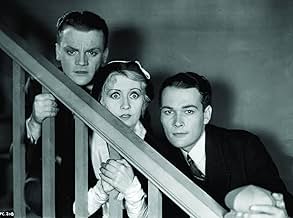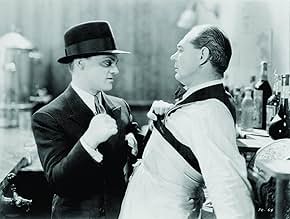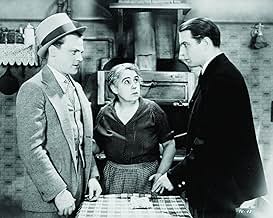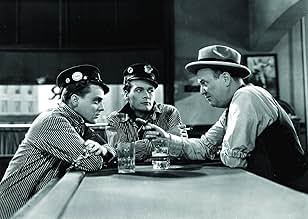Schon früh geraten die Freunde auf die schiefe Bahn. Während der Prohibition ist ihre große Zeit endlich gekommen, bald schon ist Tom als eiskalter Gangster gefürchtet.Schon früh geraten die Freunde auf die schiefe Bahn. Während der Prohibition ist ihre große Zeit endlich gekommen, bald schon ist Tom als eiskalter Gangster gefürchtet.Schon früh geraten die Freunde auf die schiefe Bahn. Während der Prohibition ist ihre große Zeit endlich gekommen, bald schon ist Tom als eiskalter Gangster gefürchtet.
- Regie
- Drehbuch
- Hauptbesetzung
- Für 1 Oscar nominiert
- 1 Gewinn & 1 Nominierung insgesamt
- Paddy Ryan
- (as Robert O'Connor)
- Goon
- (Nicht genannt)
- Dutch
- (Nicht genannt)
- Kitty
- (Nicht genannt)
- Tom as a Boy
- (Nicht genannt)
- Machine Gunner
- (Nicht genannt)
- Matt as a Boy
- (Nicht genannt)
- Miller
- (Nicht genannt)
- Molly Doyle
- (Nicht genannt)
- Nails' Girl
- (Nicht genannt)
Empfohlene Bewertungen
Through its passage in time element starting in 1909 Chicago, THE PUBLIC ENEMY plays in the biographical mode, displaying the origins of its main characters, Tom Powers and Matt Doyle, as boys (Junior Coughlan and Frankie Darro), leading to their adult lives (James Cagney and Edward Woods) as tough thugs. Tom Powers character, regardless of his fine upbringing, indicates he was born ... to be bad. He has a brother, Mike (Donald Cook) who knows of his activities, while their mother (Beryl Mercer) may suspect but overlooks his actions. As things start going well for Tom and Matt in the bootlegging racket under Paddy Ryan's (Robert Emmett O'Connor) leadership, Scheiner Burns, a rival gang leader, attempts on taking over Ryan's establishment, leading to more gun-play, especially for Tom, quick on the trigger, only to have things backfire on him.
If not the most famous of the early gangster films, THE PUBLIC ENEMY is one of the most revived. Quite frank in its actions, and adult for its intentions, much of the then so- called violence occurs out of camera range. Yet, whatever is displayed on film is something not to forget. These days, there isn't a year that goes where THE PUBLIC ENEMY isn't televised. Whenever a topic pertaining to THE PUBLIC ENEMY arises, it's not the story that immediately comes to mind, but Cagney's individual scenes consisting of squirting beer from his mouth into the bartender's face; Tom's cold-blooded killing of Putty Nose (the man who let him take the rap for a crime) while playing his last song on the piano; and Tom's off-screen shootout with a rival gang in a fancy nightclub, stumbling out in the pouring rain saying to himself, "I ain't so tough." All these scenes pale in comparison until reaching its most chilling climax ever recorded on film. Yet, the one where Tom, at the breakfast table, pushes a grapefruit into his mistress Kitty's (Mae Clarke) face, never has such a brief scene have such an long impact. Other than Clarke's famous few minutes of grapefruit glory, Mia Marvin (whose face resembling Maureen "Marcia Brady" McCormick from TV's 1970s sit-com, "The Brady Bunch") playing a slut named Jane, is one who gets her face slapped after getting Tom drunk enough to seduce him. The second billed Jean Harlow doesn't get any abuse from her leading man as did the other two actresses receiving no screen credit for their trouble. While Harlow's performance has been criticized as one of her worst, chances are her portrayal might have been intended to be enacted in that manner. Harlow's Gwen Allen is an uneducated blonde floozy with her gift for attracting men. What possibly hurts the film is not Harlow herself, but the inane dialog she recites, ("Oh Tommy, I can love you to death!". Joan Blondell's limitations on screen is mostly one involving her relation with Tom's pal, Matt. Edward Woods, whose has almost equal screen time with Cagney, is a Hollywood name very few recollect today. Several documentaries profiling gangster films have indicated Woods as the initial star of THE PUBLIC ENEMY with Cagney assuming the subordinate role, with director Wellman seeing an error with the casting and wisely having these actors switch roles. While a smart move on Wellman's part, he failed to switch roles on the boy actors who portrayed them, especially a keen observer noticing Frankie Darro playing Matt, not Junior Coughlan playing Tom, performing in the Cagney manner. Donald Cook, Beryl Mercer and Robert O'Connor appearing in subordinate roles, are essential with their parts, but never outshine Hollywood's finest movie thug, a/k/a Public Enemy, James Cagney, whose tougher roles, ANGELS WITH DIRTY FACES (1938) and WHITE HEAT (1949) were years into his future. With limited underscoring, the theme song, "I'm Forever Blowing Bubbles," like Cagney and his grapefruit, has long become associated with THE PUBLIC ENEMY.
THE PUBLIC ENEMY, which has become one of the first major movies from the Warner Brothers library to be distributed on video cassette (consisting mostly of prints from slightly edited reissues), and later on DVD (with either edited or restored prints), can be seen quite frequently on Turner Classic Movies. It might not have the realistic violence as any crime film of today, but THE PUBLIC ENEMY presents itself as a gangster drama that doesn't have to be all blood and guts to become successful. Good acting, fine story, interesting characters supplied with tight action is all what is needed to make a good movie. Being a natural talent, Cagney makes THE PUBLIC ENEMY all it's worth. (***)
Of course this film about a young man's rise to prominence in the bootleg liquor business during Prohibition made James Cagney a star. Interestingly enough Edward Woods was originally supposed to be Tom Powers and Cagney was cast as best friend Matt Doyle. After some footage had been shot, Director William Wellman scrapped it and had Cagney and Woods exchange roles. Stars get born in many and strange ways.
Some critics have complained about Beryl Mercer's part as Cagney's mother, saying she's overacts the ditziness. I disagree with that completely. In the prologue section with Cagney and Woods as juveniles, there is a two parent household. The boys have a stern Irish father and a mom who'd spoil them if she could. The older kid who is later played by Donald Cook has more the benefit of the two family home and both influences. That and the fact that World War I leaves him partially disabled prevents him from thinking about the gangster trade. Cagney misses the war and is spoiled by mom.
I knew a woman like Beryl, in her own world with a stream of nonsensical chatter to keep out the reality of things. Her portrayal for me rings true.
Oddly enough in The Roaring Twenties Cagney is a veteran who enters the rackets because he can't get a legitimate job and its easy money.
Both The Public Enemy and Little Caesar are short films, edited down to the essentials so the viewer ain't bored for a minute. Warner Brothers sure knew how to do those gangster flicks.
James Cagney wasn't originally supposed to be the lead in The Public Enemy. He was cast as the sidekick, but director William Wellman soon realised he was the better man for the top job. And it's not surprising that he stood out, despite a lack of experience. It's not deep acting ability (although he would demonstrate that later in his career), it's presence; a raw, captivating charisma. He brings a compelling life to the part of Tom Powers, much as Edward G. Robinson did in Little Caesar six months or so earlier. But whereas Robinson was more of an Al Capone figure, Cagney is more the lean, young street brawler than the cigar-chomping kingpin. The gangster genre had found the perfect actor for another of its archetypes.
Scripted by Kubec Glasmon, John Bright and Harvey Thew, The Public Enemy is at the forefront of the then-popular mob movies, mainly thanks its brutal presentation of gangland. There were plenty of movies in which hoods gunned each other down with far more abandon, but in The Public Enemy the violence is more shocking through its context. The picture begins by showing the protagonists as kids. This was ostensibly to demonstrate the origins of criminality, but by giving us that glimpse of childhood, the later fates of the characters seem all the more grim and tragic. Cagney's doting mother remains a presence throughout the movie to keep this angle going.
William Wellman was ideal for such a project, since it's violence that brings out his inventive side. A little bit of action goes a long way in a Wellman movie. When Donald Cook punches Cagney, Cagney falls and crushes a chair. At other times the director has a bit of nasty business take place off screen, something which only the new sound technology would fully allow, cunningly drawing attention to the wider context. Involving the audience is another trick. For key moments he'll change the angle so that Cagney is almost staring into the lens, bearing down upon us.
And with those piercing eyes, commanding tone and short, sharp movements, Cagney is ideal for such an aggressive visual style. And yet these very strengths would present him with one drawback. As stars began to emerge that seemed so intrinsic to the tones and tropes of one genre, typecasting set in hard. The Public Enemy is an awesome debut for Cagney, but it also formed a constricting mould this intelligent and versatile actor would struggle to break.
In my opinion a major credit of the film is that it systematically avoids cliché. Neither Tom nor Matt are outcomes of poverty and social injustice. They come from simple but honest, decent and loving families. But they are both bad (that's the word) and they use the freedom and opportunities of their democratic country to make evil.
In "The Public Enemy" we find probably the first instances of the beautiful stylish cinematography and clever camera-work that will become the trade-mark of later gangster and noir movies. Some scenes are unforgettable, like the final one, or that under the rain, or that of Cagney abusing the girl. The brief scene of the killing of the horse is pure cinematic genius.
In the film there are also some naiveness and clumsiness, though. The way Tom undergoes the personality of his good brother is far-fetched. It is not clear why a gangster in a hospital, wounded in a gun-fight, is not under strict police control. The behavior of Tom's boss in the ending is illogical. Moreover, the part where Tom and Matt are kids is too long (we audience are all eager to see Cagney!), and action is a bit scarce for a gangster movie.
"The Public Enemy" was Cagney's breakout film, and really he makes a powerful and accurate job. Actually, a strong acting is provided by the whole cast. The director William A. Wellmann handles the movie with sound talent.
"The Public Enemy" is a beautiful and historically important movie. I recommend it to any cinema-lover
The script is loosely adapted from "Beer and Blood", an unpublished book from John Bright and Kubec Glasmon on the life of Dean O'Banion, Al Capone's biggest rival. We see a variety of references to Irish mobsters, including Samuel "Nails" Morton, who was famously killed by a horse. Just like the real-life mobster, Samuel "Nails" Nathan of the film is avenged when the horse is shot.
This is, of course, Cagney's breakout role. And what better role for him? Prior to "Public Enemy", he had been a hoofer on the New York stage. This experience really solidified him as a notable actor, as he had control over his movements that others might not have. Interestingly, he was originally cast as the good guy -- the last minute switch probably saved this movie as well as marked the decision that would catapult Cagney to stardom. (Some scenes were even filmed with Cagney in the other role before director William Wellman realized his mistake.)
As for how the dance background helped his acting, critic Lincoln Kirstein noted Cagney "has an inspired sense of timing, an arrogant style, a pride in the control of his body and a conviction and lack of self-consciousness that is unique. No one expresses more clearly in terms of pictorial action the delights of violence, the overtones of a subconscious sadism, the tendency towards destruction, toward anarchy, which is the base of American sex appeal." Beautifully said.
Playwright Robert Sherwood expressed how Cagney's character was the ideal anti-hero. He wrote that Cagney "does not hesitate to represent Tom as a complete rat -- with a rat's sense of honor, a rat's capacity for human love; and when cornered, a rat's fighting courage. And what is more, although his role is consistently unsympathetic, Mr. Cagney manages to earn for Tom Powers the audience's affection and esteem."
In its own time, the film was thought of as a bit too violent, and there are a few moments that might still be considered shocking today. However, with the changing norms between the 1930s and today, what really stands out is the misogyny that barely earned a mention upon release. The most memorable scene, of course, is Cagney smashing a grapefruit into Mae Clarke's face. But his abusive language to her, suggesting his desire to drown Clarke, is hard to take and still remain empathetic with the gangster.
There are very few films that can be said to be really inspirational to the gangster film. This one, Howard Hawks' "Scarface" (1932) and "Little Caesar" (1931) are at the top of that short list. If it is not evident enough from watching the film itself, the special feature interview of Martin Scorsese should cement the deal. Author TJ English feels this is "perhaps the most influential gangster flick in the history of American movies", but that may be overstating it a little.
Some credit must be given for "Public Enemy" succeeding and remaining a top film, however. As strange as it sounds, there were at least 25 gangster movies in 1931 and at least 40 in 1932. So being among the one or two remembered almost a century later is actually quite a feat. Even William Wellman, who directed a staggering nine gangster films between 1928 and 1933 is really only remembered for this one.
Wusstest du schon
- WissenswertesOn the set one day, James Cagney stared at Jean Harlow's nipples and asked, likely in perfect innocence and good humor, "How do you keep those things up?" "I ice them," Harlow said, before trotting off to her dressing room to do just that.
- PatzerIn 1915, when Tom meets Putty Nose at the pool hall, the sign on the wall says "Don't spit of the floor. Remember the Jamestown Flood". It was the city of Johnstown, not Jamestown than had the historic flood.
- Zitate
Tom Powers: [Tom shuffles to the breakfast table in his pajamas. He's just finished a demanding call with Nails Nathan] Ain't you got a drink in the house?
Kitty: Well, not before breakfast, dear.
Tom Powers: [immediately annoyed] ... I didn't ask you for any lip. I asked you if you had a drink.
Kitty: [sheepishly] I know Tom, but I, I wish that...
Tom Powers: ... there you go with that wishin' stuff again. I wish you was a wishing well. So that I could tie a bucket to ya and sink ya.
Kitty: Well, maybe you've found someone you like better.
[Angered, Tom grimaces and shoves a piece of grapefruit in her face as he leaves the table.]
- Crazy CreditsIt is the ambition of the authors of "The Public Enemy" to honestly depict the environment that exists today in a certain strata of American life, rather than glorify the hoodlum or the criminal. While the story of "The Public Enemy" is essentially a true story, all names and characters appearing herein, are purely fictional.
- Alternative VersionenFor a 1941 re-release, three scenes in "The Public Enemy" were censored to comply with the Production Code. These censored segments (including an extended edit of the scene involving the gay tailor) were restored for the 2005 DVD release.
- VerbindungenEdited into Three on a Match (1932)
- SoundtracksI'm Forever Blowing Bubbles
(1919) (uncredited)
Music by James Kendis, James Brockman and Nat Vincent
Played at various times throughout the film
Top-Auswahl
Details
- Erscheinungsdatum
- Herkunftsland
- Offizieller Standort
- Sprache
- Auch bekannt als
- El enemigo público
- Drehorte
- Wilshire Blvd, Los Angeles, Kalifornien, USA(convertible ride with Jean Harlow)
- Produktionsfirma
- Weitere beteiligte Unternehmen bei IMDbPro anzeigen
Box Office
- Bruttoertrag in den USA und Kanada
- 1.011.520 $
- Weltweiter Bruttoertrag
- 1.214.260 $
- Laufzeit1 Stunde 23 Minuten
- Farbe
- Seitenverhältnis
- 1.37 : 1
Zu dieser Seite beitragen



